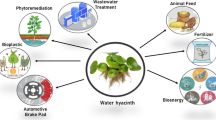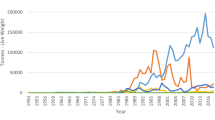Abstract
In Taiwan, Camellia seed meal is often sprayed on rice paddies during rice transplantation season to stop the growth of Pomacea canaliculata. However, the application of camellia seed meal endangers muciferous mollusks and fishes in paddy fields. Though researchers have examined the effects of the saponin in the camellia seed meal on Pomacea canaliculata, previous studies ignore the effects of saponin on fish. Loaches often inhabit the rivers, lakes, ponds, paddy fields, and canals of low elevation where there have muddy layer with plant chips. This study uses vanillin-sulfuric acid method and field tests on loaches in paddy fields to determine the duration of camellia seed meal’s effect on loaches (Misgurnue Angullicaudatus). Results indicated that the best application to stop the growth of Pomacea canaliculata is to seal the rice field immediately after transplantation, apply the camellia seed meal, and then irrigate the field 2 days after camellia seed meal application for the summer transplantation, and 3 days for the spring transplantation. Water should not be drained from the paddy field after the application of camellia seed meal to reduce the chance of endangering loaches in irrigation canals. Field Tests show that high water temperature during summer also has a negative effect on loaches in paddy fields and irrigation canals.







Similar content being viewed by others
References
Chemicals Evaluation and Research Institute (2005) A study of the eco-toxicity assessment of agriculture chemical. Ministry of the Environment (in Japanese)
Cruz MS de la, Joshi RC, Martin AR (2001) Basal application of fertilizer reduces golden apple snail population. Int Rice Res Note 26(1):20–21
Hial S, Oura H, Odaka Y, Nakajima T (1975) A colorimetric estimation of ginseng saponins. Planta Med 28:363–369
Jiang CM (2007) Taiwan paddy fields and agricultural water districts preliminary study of ecological restoration. Master Department of Civil Engineering, National Chung-Hsing University, R.O.C (in Chinese)
Kenji S, Osamu K, Akio K (1998) Movement and spawning of several freshwater fishes in temporary waters around paddy fields. Jpn J Ecol 38:35–47 (in Japanese)
Li JF, Chen RU, Zhang ZE, Chen SH, Tsai YF (2001) Organic rice cultivation techniques in Taichung area. Special issue of the Taichung District Agricultural Technology, Vol 159. The District Agricultural Improvement Station of the Agriculture Council (in Chinese)
Liao CT, Lin CS, Chang CC (2004) Biological control of the golden apple snail (Pomacea canaliculata) by black carp (Mylopharyngodon piceu) and walking catfish (Clarias batrachus). In: APEC symposium on the management of the Golden Apple Snail, 6–11 September
Liu ZY (1998) The research of camellia seed’s bio-active components. Master Department of Agricultural Chemistry, National Taiwan University (in Chinese)
Moriyama H (1997) What is the meaning of paddy field conservation? Rural Culture Association, Japan, 43–48 (in Japanese)
Nagata T, Tsushida T, Hamaya E, Enoki N, Manabe S, Nishion C (1985) Camellidns, antifungal saponins isolated from Camellia japonica. Agric Biol Chem 49:1181
Osamu K, Kazumi H, Kei’ichiroh I, Yoshimasa A (2001) Comparison of fish fauna among three types of rice fields in the Chikuma River basin. Jpn J Ichthyol 48(1):19–25 (in Japanese)
Sanico AL, Peng S, Laza RC, Visperas RM (2002) Effect of seedling age and seedling number per hill on snail damage in irrigated rice. Crop Prot 21:137–143
Takashi K (2003) Freshwater biology toxicity database of international information. Semin Biol (Ecol Environ Risk Manag) 24–29 (in Japanese)
Teo SS (2003) Damage potential of the golden apple snail Pomacea canaliculata (Lamarck) in irrigated rice and its control by cultural approaches. Int J Pest Manag 49(1):49–55
Mitsuo Y, Nishida K, Senga Y (2007) A research on habitat condition of hotoke loach in “Yatu” waters : case study of the upper stream of the Okuri River. Trans Jpn Soc Irrig Drainage Rural Eng 75(4):99–105 (in Japanese)
Zheng YC (2004) Pomacea canaliculata attractant study of master development. Master Department of Zoological Research, National Taiwan University (in Chinese)
Zheng CZ et al (1997) Essentials of health and medicine. Dragon Books Ltd, Richmond, p 65 (in Chinese)
Author information
Authors and Affiliations
Corresponding author
Rights and permissions
About this article
Cite this article
Chen, RS., Wang, KL. & Wu, CY. Assessment of the camellia seed meal impact on loaches in paddy fields. Paddy Water Environ 10, 291–300 (2012). https://doi.org/10.1007/s10333-011-0280-4
Received:
Revised:
Accepted:
Published:
Issue Date:
DOI: https://doi.org/10.1007/s10333-011-0280-4




